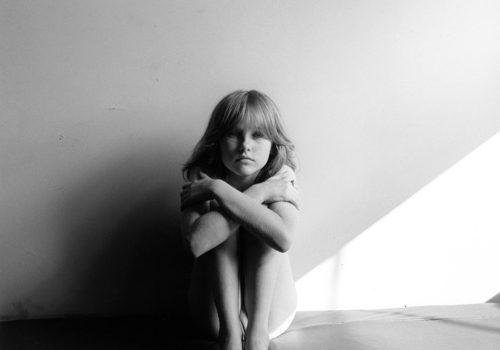Adding another chapter to a series of exhibitions aimed at rediscovering a lesser-known aspect of Robert Mapplethorpe’s work, Thaddaeus Ropac invites Jean-Marc Bustamante to express his personal view of the American photographer. Through a selection of works that explore a more intimate facet of his work, Intérieur Jour emphasizes a delicate and discreet approach to the photographic model.
Placed on two shelves that occupy the entire length of the second floor gallery, a set of portraits in various formats make up a display that recalls a domestic setting, like a family album of familiar faces.
“It is these moments that I have brought together in an intimate space of the gallery. The viewer becomes the recipient, the stakeholder, the protector of this intimacy created by the artist for rare and timeless works, imbued with a great humanity.” – Jean-Marc Bustamante
The choice is not related to the identity of the people but rather to the community they constitute, which, through its diversity, draws a portrait of the artist. Some belong to a socio-cultural elite, others are part of the New York underground and then there are the children of both. All of them are characterised by a kind of relaxed attitude with a particular lighting that underlines their humanity marked by a form of relaxation and by a play of light that underlines their humanity. Rather than the sculptural beauty of the athletic bodies that has so often been emphasised, the aim here is to let the determination of a look, the fragility of a moment and the reverie speak for itself.
From his own practice, nourished by photography, Jean-Marc Bustamante thus elaborates a reflection on the de-hierarchisation of the image that thwarts what we already know about Mapplethorpe, his search for perfection and his obsession for “the beautiful image.” Photographs of empty space, with light passing through them, accompany this gallery of portraits like counter-fields that introduce an absence, a screen. These views of interiors in which nothing is revealed except the architecture of the space itself, are indeed, through the diffusion of light, invitations to develop one’s own eye as a spectator.
Photographed in their intimate domestic space, the portraits of adults reveal a vulnerability far removed from the dramatic tension of studio portraits. Sitting on her sofa, Stella Astor (1976) looks defiantly into the lens, while the portrait of Francesca Thyssen (1981) is caught in a moment of abandon. Mapplethorpe believed that he had to have the consent of the people he photographed and once said that children were the most difficult subject to photograph: “You can’t control them. They never do what you want them to do.” These were mostly children of friends like Sarabelle Miller – the daughter of gallery owner Robert Miller, or the niece of Milton Moore – one of his favorite models. These images capture their innocence but also their sense of playfulness and confidence.
About the artist
Born into a strict Catholic family in Queens, New York, Mapplethorpe attended the Pratt Institute in Brooklyn from 1963-69, where he studied painting, sculpture and graphic design. During his formative early years, Mapplethorpe worked across media, producing numerous drawings, collages and three- dimensional objects. He began taking polaroids in 1971 and progressively incorporated photography, along with clippings from books and magazines, into his sculptural assemblages. His first solo exhibition was Polaroids at the Light Gallery, New York in 1973. He only began working exclusively with photography from the mid-1970s, when he was given a Hasselblad 500 camera by curator and collector Sam Wagstaff, who was also his mentor and lover.
In 1988, a year before his untimely death from AIDS, Mapplethorpe’s work was shown in four important exhibitions at the Stedelijk Museum, Amsterdam; Whitney Museum of American Art, New York; Institute of Contemporary Art at the University of Pennsylvania, Philadelphia; and the National Portrait Gallery, London. Recent solo exhibitions have been hosted at the Solomon R. Guggenheim Museum, New York (2019); Museo Madre, Naples (2018); Kunsthal Rotterdam (2017); Los Angeles County Museum of Art (2016); ARoS Aarhus Art Museum, Denmark (2016); Tate Modern, London (2014); and the Musée Rodin, Paris (2014). Beyond the art historical and social significance of his work, his legacy lives on through the work of the Robert Mapplethorpe Foundation, which he established in 1988 to promote photography, support museums that exhibit photographic art and fund medical research in the fight against HIV and AIDS. In 2011, the Los Angeles County Museum of Art and the J. Paul Getty Trust jointly acquired the artist’s art and archives through a generous gift from the Robert Mapplethorpe Foundation.
Robert Mapplethorpe : Intérieur Jour
Curated by Jean-Marc Bustamante
4 September—16 October 2021
Thaddaeus Ropac – Paris Marais
7, rue Debelleyme
75003 Paris
















